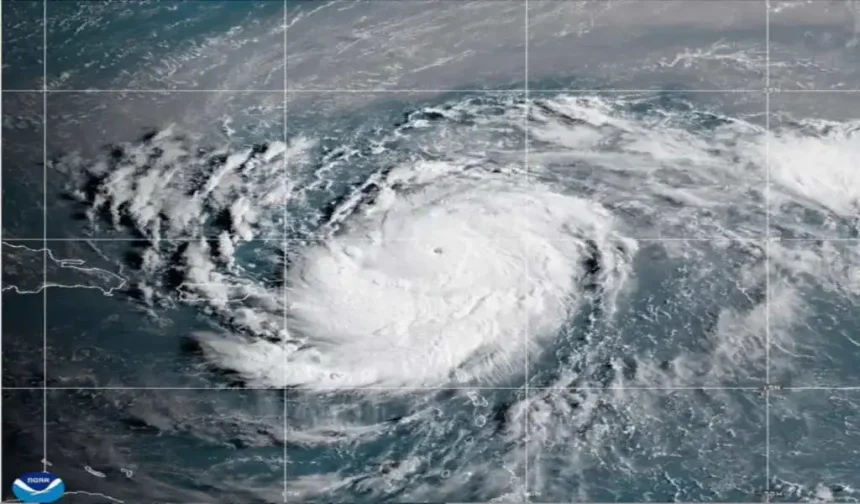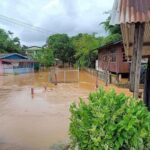(CTN News) – Hurricane Erin rapidly intensified from a tropical storm to a Category 5 hurricane in the Caribbean on Saturday.
The National Storm Center reports that Hurricane Erin escalated from a tropical storm to a Category 5 Stormwithin a single day. The compact storm’s core was not anticipated to make landfall;
However, its further intensification presented a risk of flooding due to potential heavy rainfall.
Erin rapidly intensified into a “highly formidable hurricane,” as stated by Mike Brennen, head of Miami’s National Storm Center. Within a few hours, Erin’s maximum sustained winds escalated from 100 miles per hour (160 kilometers per hour) to 160 miles per hour (257 kilometers per hour).
During an online briefing, Brennan predicted that Erin will attain her maximum intensity in a limited period. Erin developed from a tropical storm to a Category 5 Storm within twenty-four hours, marking it as the inaugural Atlantic Stormof 2025.
The maximum sustained winds on Saturday morning nearly increased to 160 miles per hour (255 kilometers per hour) during the late morning hours. On Saturday at approximately 11:00 a.m., the hurricane was situated 105 miles (170 kilometers) north of Anguilla and was advancing westward at a velocity of 17 miles per hour (28 kilometers per hour).
The storm’s center was anticipated to traverse north of Puerto Rico and the Virgin Islands, remaining over the ocean without making landfall. Erin’s presence influenced the adjacent islands. Observations of the tropical storm were reported for the islands of St. Martin, St. Barts, and St. Maarten.
The International Storm Center has cautioned that substantial precipitation in certain regions may result in mudslides, landslides, and rapid flooding. Wind surges akin to those produced by a tropical cyclone may manifest in the southeastern Bahamas and the Turks and Caicos Islands.
Although Erin was initially diminutive and exhibited hurricane-force gusts extending thirty miles (45 kilometers) from its center, forecasts indicate that the hurricane’s core may potentially double or triple in size in the forthcoming days.
Consequently, despite its expectation that it will remain offshore later in the week, the cyclone possesses the capacity to generate powerful rip currents along segments of the Northeast Coast of the United States.
According to AccuWeather, protruding coastal regions in the United States, including the Outer Banks of North Carolina, Long Island, New York, and Cape Cod, Massachusetts, exhibit greater susceptibility to direct and potentially severe tropical storms or hurricanes compared to the majority of the southern Atlantic, mid-Atlantic, and northern New England coasts.
Researchers have identified a correlation between climate change and the escalating severity of storms in the Atlantic Ocean. The increase in atmospheric water vapor due to global warming is causing a rise in ocean temperatures.
The warming waters can intensify hurricanes and increase precipitation.
The rapid intensification of storms complicates meteorologists’ ability to generate precise forecasts and hinders governmental agencies’ preparedness for catastrophic events.
Furthermore, the intensity of Hurricane Erick, which originated in the Pacific and made landfall in Oaxaca, Mexico, on June 19, markedly escalated, doubling in strength within a span of less than twenty-four hours.
From June 1 to November 30, Erin is designated as the fifth storm of the Atlantic hurricane season. This storm is the first to evolve into a hurricane.
Unprecedented activity is expected in the 2025 cyclone season. Three to five cyclones are anticipated to escalate into substantial storms, featuring maximum sustained winds of 110 mph (177 km/h). It is anticipated that six to ten Strom may develop in total.
The U.S. government has dispatched approximately two hundred personnel to Puerto Rico, including members of the Federal Emergency Management Agency, as a precautionary measure. This follows the issuance of a flood monitor for the whole United States, effective from late Friday through Monday.
Ciary Pérez Peña, Puerto Rico’s Secretary of Housing, announced that 367 shelters have been evaluated and are prepared for activation if necessary. In a statement issued on Friday, the US Coast Guard informed the public that all inbound vessels are prohibited from entering six seaports in Puerto Rico and two in the US Virgin Islands without prior authorization.
Officials in the Bahamas announced the initiation of preparations for public shelters as a precautionary measure during this period and urged citizens to monitor the hurricane closely.
Aarone Sargent, the general director of the Bahamas’ disaster management agency, stated, “These storms are highly volatile and can result in sudden alterations to their trajectory.”
SOURCE: NPR
SEE ALSO:
What Did Trump and Putin’s Talks in Alaska Achieve?
Authorities in Laos Seize 8.8 Million Meth Pills Hidden in Beer Shipment
Pickup Runs Red Light Hits Motorcycle, Killing Couple and Their 4-Year-Old Daughter















